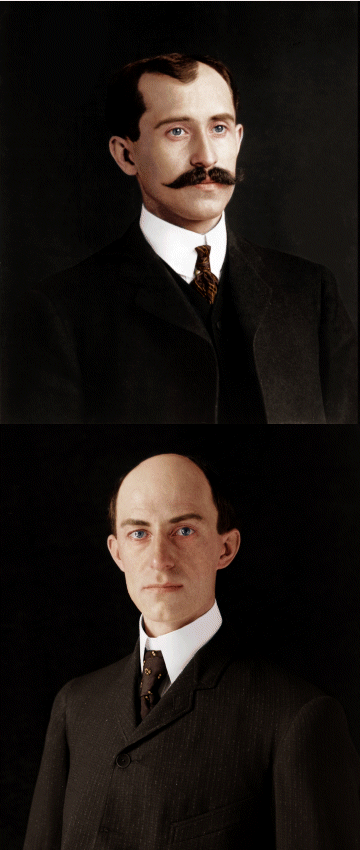Crazy Days
Brothers in the Air
Brothers in the Air
The Wright Brothers, Orville Wright (1871 - 1948) and Wilbur Wright (1867 - 1912), invented powered heavier-than-air flight. The brothers grew up in Dayton, Ohio, where they ran a bicycle shop. Drawing on the work of Sir George Cayley, they extended the technology of flight with the principles of control still used today. They had researched and initially relied upon the aeronautical literature of the day, including Otto Lilienthal's tables but, finding that they had errors, designed and built a wind tunnel to perform practical tests.
In 1903 they went to Kitty Hawk, North Carolina to continue their aeronautical work, choosing Kitty Hawk (actually Kill Devil Hill) because of its strong and steady winds, and on March 23, 1903 they applied for a patent for their airplane design. Then on December 17, 1903 Orville Wright took to the air. Orville's uncontrolled flight, of 120 feet in 12 seconds, was recorded in a famous photograph. In the fourth flight of the same day, the only made that day which was actually controlled, Wilbur Wright flew 852 feet in 59 seconds.
 Brothers in the air: Wilbur and Orville Wright were the first men to prove powered flight was feasible.
Brothers in the air: Wilbur and Orville Wright were the first men to prove powered flight was feasible.The Wright brothers invited only a few witnesses to their early flights, in order to protect their patent rights.
The Wrights established a flying field at Huffman Prairie, near Dayton, Ohio, and continued work in 1904, using a a catapult takeoff system to compensate for the lack of wind in this location. By the end of the year, the Wright brothers had sustained flights of 5 minutes, circling over Huffman Prairie.
Controversy in the credit for invention of the airplane has been fueled by the Wrights' secrecy while their patent was prepared, by the pride of nations, and by the number of firsts made possible by the basic invention.
The Wright Company was the commercial aviation business venture of the Wright Brothers, established by them on 22 Novemeber 1909 in conjunction with several prominent industrialists from New York and Detroit with the intention of capitalizing on their invention of the practical airplane. The company maintained its headquarters office in New York City and built its factory in Dayton, Ohio.
The two buildings designed by Dayton architect William Earl Russ and built by Rouzer Construction for the Wright Company in Dayton in 1910 and 1911 were the first in the United States constructed specifically for an airplane factory and were included within the boundary of Dayton Aviation Heritage National Historical Park in 2009.
The Wright Company concentrated its efforts on protecting the company's patent rights rather than on developing new aircraft or aircraft components, believing that innovations would hurt the company's efforts to obtain royalties from competing manufacturers or patent infringers. Wilbur Wright died in 1912, and on October 15, 1915, Orville Wright sold the company, which in 1916 merged with the Glenn L. Martin Company to form the Wright-Martin Company. Orville Wright estimated that the Wright Company built approximately 120 airplanes across all of its different models between 1910 and 1915.
Many of the papers of the Wright Company are now in the collection of the Seattle Museum of Flight, while others are held by the Library of Congress in Washington, D.C. The Library of Congress also holds the papers of Grover Loening, the second Wright Company factory manager, while the papers of Frank H. Russell, the first plant manager, are at the University of Wyoming's American Heritage Center.